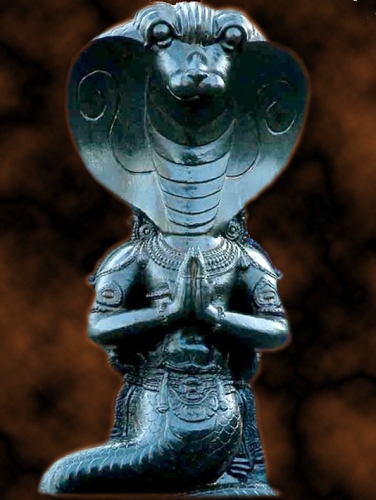
We have noticed further questions about Ketu raised by search engines which bring visitors to this site, so we will engage in more discussion about Ketu and address some of the questions raised: Ketu in various nakshatras, Ketu and the Moon, Ketu and Mars conjunction. And if there is time, we may address Ketu and Spirituality. We keep in mind that Ketu is a shadow planet, a karmic repository and an important agent on the journey toward the goal of life. Ketu (which means flag) actually flags important staging posts on the human journey of return to the Source.
Ketu, the opposite node to Rahu, came into being during the churning of the Ocean of Milk. The last gift of that churning was the emergence of the God of Healing, Dhanvantari, with the pot of amrit, the nectar of immortality. Ketu and Rahu were whole at that time, in the form of a demon known as Swabharnu, who engaged in subterfuge to obtain the nectar whilst it was being served out by the enchantress Mohini. The deception was discovered by the Sun and Moon, who ran tale-telling to the great God Maha Vishnu, who promptly sent his discus and separated the head from the body; the body is today known as Lord Ketu, South Node of the Moon.
Ketu, one of two nodes (which are said to be terrible in nature) is born in the race of Asuras (when whole; and when whole as the demon Swabharnu, held the title of Minister of the Asuras, a high position). Nodes are said to eclipse the lives of living beings, and eclipse the mind when they conjoin the luminaries. (The two nodes are non-luminary planets, what in vedic astrology is called shadow planets.) Ketu is a beheaded asura. It is important to remember that the planets are grahas, seizers, they take hold of, grab, capture, particularly in times of eclipses, which are times of inner transformation.
Ketu and the Moon
It is important to recall that where boundaries are concerned, Rahu is pushing the outer boundaries and taking advances in territory, activity, karma, that is attractive. Ketu on the other hand is maintaining inner boundaries and inner territory. Ketu may appear to have weak social skills, weak social networks and somewhat isolated, if not mistaken for aspergers syndrome or autism. Beware, those with conditions have very narrow, vertical spheres of information and knowledge which can be astounding in their depth, breadth and grasp of their favoured territory. Do not mistake the depth of Ketu for mental affliction and illness.
A Ketu – Moon conjunction happens every 29.53 days, that is, in every lunar month: this is called gochara, transit. Interpretation of these transits depends largely on Vimshottari Dasha running at the time, and more particularly, the Antar (bhukti) dasha; if it be Ketu, then close attention to the transit is required. Recall that the bhukti affects the maha dasha and causes the ruling planet to behave like the bhukti planet: the influence is strong.
A Ketu – Moon conjunction in the birth chart indicates emotional disconnection. It is very much a separation of head and heart. There can indicate a tendency to lack of empathy and compassion; it is a tendency, which has to be confirmed by other planetary placements and aspects. One’s character is evinced by thought, word and action. While feelings may not feature in the process of decision making, the inner resident is in the heart of the person, and it is from the inner resident, the atmajyoti within that the intellect receives over 80% of its illumination and energy. Heartfelt decisions can be made by persons with Ketu-Moon conjunction; they require more effort and digging deeper, that is all.
Ketu conjunct Mars
The teaching in Vedic Astrology is Kuja vat Ketu, Ketu will behave like Mars. Ketu will be of pitta (fire) dosha, and magnify a Mars-like impact on the sign or house it occupies or aspects, and like so on planets it is conjunct or aspecting. Ketu is ever moving backwards in the birth chart, and takes 18 months to move through a sign. When we consider Ketu and Mars, we recall that Mars is the Commander-in-Chief of the Army who will expend a significant amount of energy in pursuit of a goal. Ketu would rather invest energy in pursuit of inner, aesthetic – and spiritual – goals. Mars conjunct Ketu tends to be passive-aggressive event where inner goals rule over outer action, and the outcomes can be somewhat incendiary; there can be a Pyrrhic victory, a war that is won that has no spoils of victory; an empty victory on the outer and inner levels. Ketu can spend enormous resources defending inner boundaries. When challenged in the outer world about pursuit of goals and the driving motive behind actions, Ketu conjunct Mars appears to be vacuous, dissemble and be manipulative.
Ketu and Spirituality
It is possible for Ketu conjunct Mars to produce a person of significant spiritual discipline and mastery. Mars supplies external discipline and control over the mind, body and senses. (Recall that one offers one’s tan (body), man (mind) and dhan (wealth) to the guru.) Mars supplies the external self control over appetite, body, breathing, and adapts well to ashram or spiritual discipline. Ketu explores the teachings, the power of maya, the veil that hides the Divine from one and all. It is via this power of maya which is subjectively experienced that Ketu can objectify – discover the divinity immanent in all that is – and pierce this veil of illusion that we are separate from the Divine.
Ketu in this instance is perfectly capable of being the monk in community, the monk in a solitary cell, the renunciate, the sanyasin, the stylite living atop a pillar. Penance, sacrifice, self-discipline, the path of asceticism and seclusion is well suited to the Ketu influence on the human person. (Much depends on the placement of Ketu, who does not do so well in some signs and houses.) In this world of frequent communications, it would not be surprising if the influence of Ketu were to make one abandon (or lose and not care one whit about) one’s mobile electronic devices such as the smartphone, the tablet, etc. Such is meaningless to the Ketu individual who seeks the inner paths. Inner illumination and development and piercing the veil of maya requires that we spend up to 75% of our time in self-inquiry. Think of Buddhist monks and their koans. Of what use are mobile phones to such individuals?

Qala’at Samaan is the site of the remains of the early Christian monastic complex that developed around the pillar of the famous ascetic and saint Symeon the Stylite (d. 459). During his lifetime, Christian pilgrims travelled from all over the world to visit Symeon, whose ascetic practice included standing on a platform atop a tall stone pillar for almost forty years.
Ketu is ruled by Chitragupta, the god who gives the full past life recall; sometimes called the recorder of one’s deeds. Chitragupta is related to Yama, the god of death, who is also the god of Dharma, the practice of righteousness, the following of right conduct. Ketu is the karmic container, the repository of the karma selected for consumption in the current life. The supreme deity of Ketu is Brahma, the giver of spiritual knowledge. As Jupiter is the outer guru in the external environment of the human, Brahma is the inner guru in the internal environment of the human. Pandit Vamadeva tells that at a higher level, Ketu relates the formless Brahman or transcendent reality. Brahman pervades all that exists, and it is through the agency of Ketu driving inner, internal self-enquiry, one comes to know that the invisible, formless Brahman is known as immanent and transcendent in the material world of manifestation.
Where Rahu is materialistic, Ketu is detached; Where Rahu acquires friends, associates and makes connections in order to propel himself forward and upward, Ketu has vague social networks and does not presume to progress in the outer world. Ketu in the 12th house (especially Sagittarius or Pisces) is an excellent placement for spiritual pursuits or long term sadhana comparable to Tapasya. Ketu’s capacity for external disconnection aids management of the outward going mind, the desires, the senses. Ketu in the 12th house (commonly called the place of bed-pleasures) experiences a lack of sexual activity and cannot be disposer of bedroom delights as Venus can. Just so, Venus cannot dispose what Ketu can give to the individual.
Help on the Ketu Journey
Due the weak social networking occasioned by Ketu, it is useful to have a learning partner on whatever path one takes through life. On the spiritual journey, one has a spiritual director, a holy listener, a guru, guardian, spiritual guide. In the mundane areas of life, learning partners can be found at school, in higher education and in specialist learning groups. The function of a learning partner is to listen, reflect, provide feedback, suggestions and re-assurance on the path chosen. One is born in society and culture, which gives you your wealth, health, and education. All need appropriate support on their stages through life; one does not reach the goal of life – or indeed, one’s personal goals without the support structures of society and culture that one lives in. Our parents are our first learning partners. We can have learning partners in every stage of the journey of life, be it in family, at school, in relationships, at work, in recreation.
The down side of Ketu is gloom, despondency, lethargy, chronic fatigue, entropy. Ketu removes whatever support structures that are within the person. The coat-hanger of seeing the world can literally disappear. Ketu can be completely disconnected on a social level, often the outcast, forgotten in mental institutions with long-term mental illnesses. Just as Ketu is disembodied and can be disconnected from feeling and emotion, taken to extremes, this can result in complete deprivation of intimacy, passion and commitment in any relationship. In such situations, remedies for an afflicted Ketu – perhaps conjunct malefic planets in the birth chart – must be found and put into place.

cells for ascetics carved out of rocks
![]()
